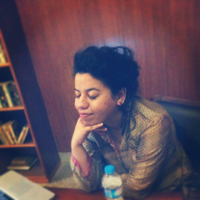Comments (2)

I like the difference in color in the painting that creates a nice atmosphere. I also like the depth of the background and how detailed it is!

We do our best to use images that are open source. If you feel we have used an image of yours inappropriately please let us know and we will fix it.
Our writing can be punchy but we do our level best to ensure the material is accurate. If you believe we have made a mistake, please let us know.
If you are planning to see an artwork, please keep in mind that while the art we cover is held in permanent collections, pieces are sometimes removed from display for renovation or traveling exhibitions.

Contributor
Though he had been just a simple boy from humble means, Rolin earned some major social capital when he was made a chancellor to Philip the Good, Duke of Burgundy in 1422. ‘Course, being influential and powerful in the world wasn’t enough for this aspirational fellow. So he had this portrait of himself commissioned next to what was at that time considered THE coolest peeps to have ever graced God’s green earth: Mary and JC, of course!
The middle-aged Rolin’s alert gaze may seem charged by several espresso shots, but before you reach for that bag of dark roast, know this: this is the look you get when you’ve spent many hours praying and reading the good book. So break out the Bible instead, folks, and replace those coffee beans with some rosary beads. Plus, you gotta look that perky when their Holinesses are paying you a visit. Probably also why Rolin wore his good mink-trimmed brocade jacket that day. He still can’t hold a candle to young JC, who is in the buff with an angel hovering nearby with a bangin’ crown to tell the world that he is, inarguably, the king. Also, if you squint really hard, you see two peacocks out on the terrace that were supposedly symbols of immortality. Or the fact that Rolin could dole out the ducats to pay for fancy birds, both in the painting and in real life.
Even though the figures are painted like, super well, the really awesome feature of this painting is the background and the landscape. First of all, hello spatial depth! Look at that tile work that recedes so beautifully and convincingly. Not too shabby for a Flanders man, van Eyck! Then there’s the landscape you see (if you squint even harder, or use the zoom tool if you’re smart). I can’t even with all that crazy detail! There are little towers, a twisty river, houses, teeny figures, a cathedral, and lots more! The landscape stretches out into a hazy distance to give us the impression of its mysterious continuity, and also to remind us that van Eyck knew his oil paints better than anyone in that day and age. Charles de Tolnay, art historian to the stars, said that the painting represented a comprehensive vision of the entire universe. Couldn’t have said it better myself.
Featured Content

The Madonna of Chancellor Rolin is an oil painting by the Early Netherlandish painter Jan van Eyck, dating from around 1435. It is now in the Musée du Louvre, Paris. It was commissioned by Nicolas Rolin chancellor of the Duchy of Burgundy, then aged about 60, whose votive portrait takes up the left side of the picture, for his parish church, Notre-Dame-du-Chastel in Autun, where it remained until the church burnt down in 1793. After a period in Autun Cathedral, it was moved to the Louvre in 1805.
In 2024, following conservation, the painting was the focus of an exhibition at the Louvre.
Check out the full Wikipedia article about Madonna of Chancellor Rolin

I like the difference in color in the painting that creates a nice atmosphere. I also like the depth of the background and how detailed it is!
I like it because it has different colors and makes me feel comfortable.